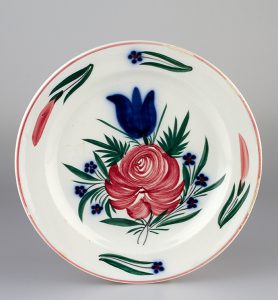


Brushwork decoration on refined white earthenware, porcelain and faience
Decorating pottery using a brush usually results in thinner and sometimes translucent, finer and more differentiated coats of paint that do not stand out in relief like many slip-trailed decorations. Brushwork decoration was therefore mainly used on faience, refined white earthenware, stoneware and porcelain. It is possible to distinguish between underglaze painting (e.g. underglaze brushwork decoration), in-glaze painted decoration and overglaze painted decoration. All three techniques could be combined with various other types of decoration.
Brushwork decoration on earthenware consisted of blue, red, or more rarely, polychrome painted patterns on a coat of white slip under the glaze. Known as underglaze brushwork decoration, the technique was used to imitate the colourful designs on faience vessels. Other popular brushwork patterns on simple earthenware were painted in red iron oxide, for instance, on the necks of single-handled jars made of light-coloured earthenware with glaze on the inside.
Translation Sandy Haemmerle
German: Pinseldekor
French: décor au pinceau

